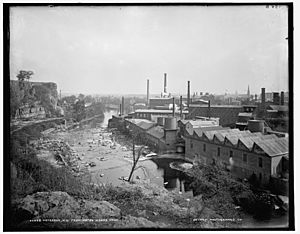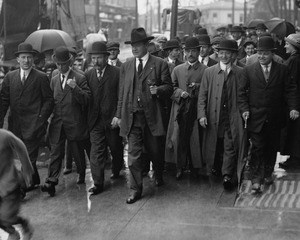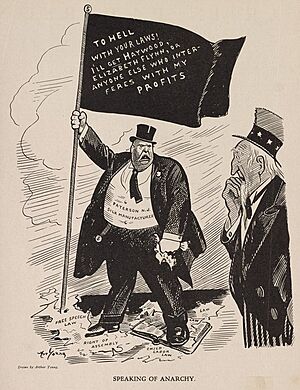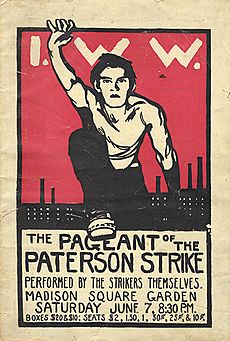1913 Paterson silk strike facts for kids
Quick facts for kids Paterson silk strike |
|
|---|---|
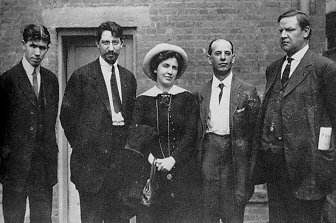
Strike leaders Patrick L. Quinlan, Carlo Tresca, Elizabeth Gurley Flynn, Adolph Lessig, and Bill Haywood.
|
|
| Location | |
| Goals | Eight-hour workday |
| Methods | Strikes, protest, demonstrations |
The 1913 Paterson Silk Strike was when workers in silk factories in Paterson, New Jersey stopped working. They wanted an eight-hour day (working only 8 hours a day) and better conditions at work. The strike started in February 1913 and lasted for five months, ending on July 28. About 1,850 workers were arrested, including leaders from a group called the Industrial Workers of the World (IWW), like Bill Haywood and Elizabeth Gurley Flynn.
Contents
Why the Strike Happened
The Paterson strike was part of many worker protests in American clothing and textile factories between 1909 and 1913. Most of these workers were immigrants from southern and eastern Europe.
A big moment for these worker movements happened in 1912 during the Lawrence Textile Strike in Massachusetts. There, workers successfully pushed factory owners to raise wages. This success encouraged people in Paterson to fight for better working conditions and pay for their silk weavers.
Paterson workers went on strike after years of low wages, bad working conditions, and very long work days. More women and children were working, which meant factory owners could pay less. Also, new machines made it easier to produce silk, so less skilled workers were needed. This meant wages went down for many.
New technology in other states like Pennsylvania and Rhode Island allowed weavers to run many looms at once. This made their silk cheaper to produce. To keep up, Paterson factories had to use these new machines too. But skilled weavers, especially those making ribbons, worried about losing their jobs. All the weavers wanted shorter work days and a set minimum wage.
The Strike Begins
The Industrial Workers of the World (IWW) helped organize both the Lawrence and Paterson strikes. On February 25, 1913, the first day of the strike, IWW leader Elizabeth Gurley Flynn was arrested. She had given a speech about uniting workers from different backgrounds. Authorities said she was causing trouble with her speeches.
Even after IWW leaders were arrested, the strikes continued for months. This showed that the workers were not just being told what to do by outsiders. The IWW believed in workers organizing themselves. Bill Haywood, one of the IWW's founders, helped Paterson strikers create a strike committee. This committee included workers from all the different nationalities, and it was run by the workers themselves. This made the Paterson strike special because it was very organized by the workers, not just by a few leaders.
The 1913 strike in Paterson was partly caused by the Doherty Silk Company building a new, modern factory in nearby Clifton, New Jersey in 1911. This new factory used machines that let weavers run many looms at once. Workers worried that all Paterson factories would do the same, leading to job losses.
In response, sixty weavers went on strike. This led to meetings to discuss wages for silk workers. The next year, a group called the Eight-Hour League was formed in Paterson, pushing for an eight-hour workday. This set the stage for the 1913 strike.
With the IWW's help, thousands of Paterson silk workers joined a general strike. Two weeks into the strike, all types of weavers worked together to make a list of demands for the factory owners. These demands included stopping child labor and getting rid of the multiple-loom systems to save jobs.
Ribbon weavers were skilled workers who had protested before. They helped teach other strikers about their rights. They also wanted higher wages because they felt they were producing more with the new looms. They even demanded that the three- and four-loom systems be removed completely. They believed these machines were taking their jobs and lowering their pay.
The factory owners responded with a statement saying the demands were not possible for their businesses. In the end, the strike failed on July 28, 1913. One big reason was that Paterson factories had to use new machines and cheaper labor to compete with other companies. If they didn't, they would go out of business.
Pageant in Madison Square Garden
To help the strike financially and get public support, artists and thinkers in New York City had an idea. They included people like Walter Lippmann, Max Eastman, Mabel Dodge Luhan, and John Reed. They decided to create a play that showed the events of the strike.
Bill Haywood and the strike committee worked closely with John Reed to write and stage the play. It included the workers' own ideas and experiences. The workers even used their own speeches and wrote some of the music. Between 800 and 1000 workers took part in the Paterson Strike Pageant. It was held at Madison Square Garden on June 7, 1913, and about 150,000 people came to watch.
The strikers traveled to Manhattan by train and marched up Fifth Avenue before the show. This was like a big protest before the performance. The pageant told the story of the strike in different parts, and the audience was even invited to participate.
The Strike Ends
Even with the pageant, which lost money, the strikers were defeated. The IWW did help some hungry children of the strikers find foster homes and get food. Although the workers had shut down Paterson and stopped the American Federation of Labor (AFL) from weakening their strike, they could not get workers in other factories in Pennsylvania to join.
The Paterson factory owners won, but they were worried and did not make big changes for another ten years. The defeat caused problems among strike supporters, and the IWW never fully recovered in Eastern America.
What We Remember Today
Two people died during the strike: Valentino Modestino, a bystander shot by a private guard, and Vincenzo Madonna, a striking worker shot by someone trying to break the strike.
The strike was shown in the 1981 movie Reds. Today, it is remembered at the Pietro and Maria Botto House National Landmark in Haledon, New Jersey. This house was a meeting place during the strike. In 1934, there was another silk strike in Paterson.


